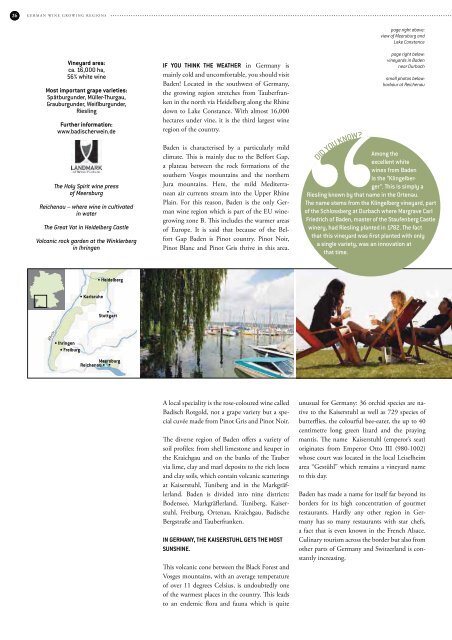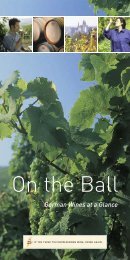the magazine of the german wine institute - Wines of Germany
the magazine of the german wine institute - Wines of Germany
the magazine of the german wine institute - Wines of Germany
You also want an ePaper? Increase the reach of your titles
YUMPU automatically turns print PDFs into web optimized ePapers that Google loves.
35 26<br />
GERMAN WINE GROWING REGIONS<br />
Vineyard area:<br />
ca. 16,000 ha,<br />
56% white <strong>wine</strong><br />
Most important grape varieties:<br />
Spätburgunder, Müller-Thurgau,<br />
Grauburgunder, Weißburgunder,<br />
Riesling<br />
Fur<strong>the</strong>r information:<br />
www.badischerwein.de<br />
The Holy Spirit <strong>wine</strong> press<br />
<strong>of</strong> Meersburg<br />
Reichenau – where <strong>wine</strong> in cultivated<br />
in water<br />
The Great Vat in Heidelberg Castle<br />
Volcanic rock garden at <strong>the</strong> Winklerberg<br />
in Ihringen<br />
Rhein<br />
����������<br />
����������<br />
�����������<br />
������������<br />
��<br />
Stuttgart<br />
�����������<br />
Meersburg<br />
�<br />
IF YOU THINK THE WEATHER in <strong>Germany</strong> is<br />
mainly cold and uncomfortable, you should visit<br />
Baden! Located in <strong>the</strong> southwest <strong>of</strong> <strong>Germany</strong>,<br />
<strong>the</strong> growing region stretches from Tauberfranken<br />
in <strong>the</strong> north via Heidelberg along <strong>the</strong> Rhine<br />
down to Lake Constance. With almost 16,000<br />
hectares under vine, it is <strong>the</strong> third largest <strong>wine</strong><br />
region <strong>of</strong> <strong>the</strong> country.<br />
Baden is characterised by a particularly mild<br />
climate. This is mainly due to <strong>the</strong> Belfort Gap,<br />
a plateau between <strong>the</strong> rock formations <strong>of</strong> <strong>the</strong><br />
sou<strong>the</strong>rn Vosges mountains and <strong>the</strong> nor<strong>the</strong>rn<br />
Jura mountains. Here, <strong>the</strong> mild Mediterranean<br />
air currents stream into <strong>the</strong> Upper Rhine<br />
Plain. For this reason, Baden is <strong>the</strong> only German<br />
<strong>wine</strong> region which is part <strong>of</strong> <strong>the</strong> EU <strong>wine</strong>growing<br />
zone B. This includes <strong>the</strong> warmer areas<br />
<strong>of</strong> Europe. It is said that because <strong>of</strong> <strong>the</strong> Belfort<br />
Gap Baden is Pinot country. Pinot Noir,<br />
Pinot Blanc and Pinot Gris thrive in this area.<br />
A local speciality is <strong>the</strong> rose-coloured <strong>wine</strong> called<br />
Badisch Rotgold, not a grape variety but a special<br />
cuvée made from Pinot Gris and Pinot Noir.<br />
The diverse region <strong>of</strong> Baden <strong>of</strong>fers a variety <strong>of</strong><br />
soil pr<strong>of</strong>iles: from shell limestone and keuper in<br />
<strong>the</strong> Kraichgau and on <strong>the</strong> banks <strong>of</strong> <strong>the</strong> Tauber<br />
via lime, clay and marl deposits to <strong>the</strong> rich loess<br />
and clay soils, which contain volcanic scatterings<br />
at Kaiserstuhl, Tuniberg and in <strong>the</strong> Markgräflerland.<br />
Baden is divided into nine districts:<br />
Bodensee, Markgräflerland, Tuniberg, Kaiserstuhl,<br />
Freiburg, Ortenau, Kraichgau, Badische<br />
Bergstraße and Tauberfranken.<br />
IN GERMANY, THE KAISERSTUHL GETS THE MOST<br />
SUNSHINE.<br />
This volcanic cone between <strong>the</strong> Black Forest and<br />
Vosges mountains, with an average temperature<br />
<strong>of</strong> over 11 degrees Celsius, is undoubtedly one<br />
<strong>of</strong> <strong>the</strong> warmest places in <strong>the</strong> country. This leads<br />
to an endemic flora and fauna which is quite<br />
page right above:<br />
view <strong>of</strong> Meersburg and<br />
Lake Constance<br />
page right below:<br />
vineyards in Baden<br />
near Durbach<br />
small photos below:<br />
harbour at Reichenau<br />
Among <strong>the</strong><br />
excellent white<br />
<strong>wine</strong>s from Baden<br />
is <strong>the</strong> “Klingelberger”.<br />
This is simply a<br />
Riesling known by that name in <strong>the</strong> Ortenau.<br />
The name stems from <strong>the</strong> Klingelberg vineyard, part<br />
<strong>of</strong> <strong>the</strong> Schlossberg at Durbach where Margrave Carl<br />
Friedrich <strong>of</strong> Baden, master <strong>of</strong> <strong>the</strong> Staufenberg Castle<br />
<strong>wine</strong>ry, had Riesling planted in 1782. The fact<br />
that this vineyard was first planted with only<br />
a single variety, was an innovation at<br />
that time.<br />
DID YOU KNOW?<br />
unusual for <strong>Germany</strong>: 36 orchid species are native<br />
to <strong>the</strong> Kaiserstuhl as well as 729 species <strong>of</strong><br />
butterflies, <strong>the</strong> colourful bee-eater, <strong>the</strong> up to 40<br />
centimetre long green lizard and <strong>the</strong> praying<br />
mantis. The name Kaiserstuhl (emperor’s seat)<br />
originates from Emperor Otto III (980-1002)<br />
whose court was located in <strong>the</strong> local Leiselheim<br />
area “Gestühl” which remains a vineyard name<br />
to this day.<br />
Baden has made a name for itself far beyond its<br />
borders for its high concentration <strong>of</strong> gourmet<br />
restaurants. Hardly any o<strong>the</strong>r region in <strong>Germany</strong><br />
has so many restaurants with star chefs,<br />
a fact that is even known in <strong>the</strong> French Alsace.<br />
Culinary tourism across <strong>the</strong> border but also from<br />
o<strong>the</strong>r parts <strong>of</strong> <strong>Germany</strong> and Switzerland is constantly<br />
increasing.



